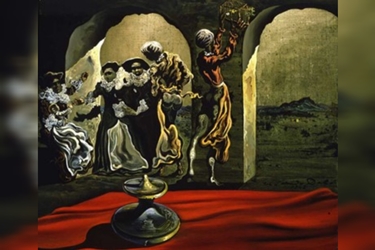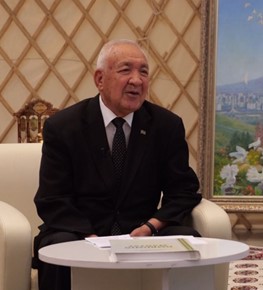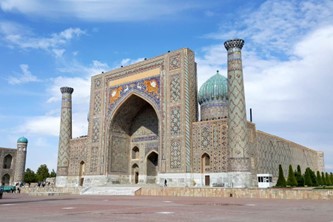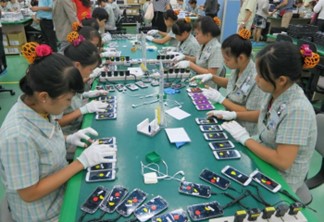Dr. Begench Karaev
Part 3.
Eastern Diplomat: A Closer Look
Winter January morning. More precisely – 7:58 am. Although there is not much time left before sunrise, it is nevertheless dark enough to not turn on the car’s headlights. I taxi out onto a small street that runs parallel to the fence of one of the foreign embassies. At the house next to it I see the silhouette of a man standing at the turn, who, noticing the glare of a headlight, takes a barely visible step towards. As the silhouette gets closer, I lightly press the brake. The clock on the dashboard of the German Opel shows exactly 8:00. A man of average height, with impeccable posture, elegantly dressed in a dark gray raglan raincoat, opens the car door with measured hand movements and gently sits down on the right side of the driver, that is, me. This man, who is entering his ninth decade of life, is the envy of everyone; the morning vigor is combined with the calmness of the rising sun. Always smart and collected, freshly shaved and attentive to others.
«Essalomaleikim, Sapar Komekovich! With these words I greet my fellow traveler and at the same time passenger Sapar Berdyniyazov is a veteran of the diplomatic service with almost half a century of experience, having worked for several decades in a number of countries in the Middle East and South Asia. His kind gaze with a barely noticeable concentration in his eyes reveals the habit, developed over the years, of maintaining leisurely regularity, both in movement and in words.
As a rule, Sapar Komekovich stipulates the time of the meeting once, and does not specify it again, even with a phone call. He carefully observes discipline and appears exactly at 8:00 in the morning at the appointed place. Being an experienced orientalist, he thus adheres to “German” accuracy. For almost a quarter of an hour on our route to work, he listens carefully to my oral version of the “feed” of international news with accompanying comments. Upon arrival at the Institute of International Relations, where he now teaches, fifteen minutes before classes start, he brews himself a cup of black coffee. Here already, Sapar Komekovich gives his brief summary to the “road briefing”, the logic of which largely allows us to see the causal connections of current events in the world and the region.
And our subsequent “big conversation” with a detailed analysis of the international situation takes place after his lectures to international relations students, who in truth are listening to the “living voice” of the diplomatic history of the modern East. He does not “give” a lecture, as they say, but enthusiastically, with the passion of a storyteller, talks about the history, national characteristics and traditions of countries and peoples.
The so-called “Kamchadals,” that is, those sitting on the farthest periphery of the audience, also try to catch the course of his leisurely reasoning. The soft and reasonable voice of Berdyniyazov, the lecturer, turns out to be able to suppress the instinctive attachment of today’s youth to all kinds of gadgets, the Internet and, ultimately, to social networks. Indeed, today it is not so easy to capture the attention of a student audience, much less to surprise them with traditional lectures. Because today’s “smart” generation gets access to relevant information online from parallel sources “www”. These so-called “smart phones” often even emerge victorious in the “intellectual competition” if the teacher turns out to be boring or not sufficiently informed about the current international situation.
 Sapar Berdyniyazov’s lectures contain not only a statement of the essence of the topic, but are accompanied by reasoning with an analytical assessment of its key points. The logic of his “thinking out loud” involuntarily draws the attention of young men and women to the complex vicissitudes of international life and diplomatic art. The abstraction of theoretical calculations finds its practical embodiment in the form of historical events, which are also seasoned with oriental flavor and the mysteries of political intrigue in the “secret” style actions.
Sapar Berdyniyazov’s lectures contain not only a statement of the essence of the topic, but are accompanied by reasoning with an analytical assessment of its key points. The logic of his “thinking out loud” involuntarily draws the attention of young men and women to the complex vicissitudes of international life and diplomatic art. The abstraction of theoretical calculations finds its practical embodiment in the form of historical events, which are also seasoned with oriental flavor and the mysteries of political intrigue in the “secret” style actions.
It is clear from everything that Sapar Komekovich treats not only his teaching work with love and respect, but also his students, who are the same age as his grandchildren. Talking about the past labyrinths of politics and diplomacy, he at the same time, as if with all seriousness, “reports” information from the past, accompanying his “report” with the necessary details, and, if necessary, supporting them with some figures. This testifies to his high sense of responsibility to the younger generation, who need not so much instruction as advice necessary for their future profession.
An indispensable attribute of the “big change” is green aromatic tea, over which an exchange of views takes place on more pressing issues of modern diplomacy. Against the backdrop of current international events, we have something to exchange opinions on that are of interest in scientific, theoretical and analytical and applied terms. This is also very relevant in the context of studying regional relations, which are influenced by broader global processes.
This time we are talking about the fragility of the current balance of power in the world. This is especially noticeable when the slightest mistake can negatively affect the situation in strategic areas of the world. In particular, sometimes even a targeted “piece” of information can create a mine effect, creating confusion in high-tech control systems filled with elements of AI – artificial intelligence. Nowadays, when the development of some auxiliary aspects in solving strategic problems is entrusted to the currently popular “neural networks,” the so-called “fake machines” may well take on the role of military weapons.
Reasoning about this, during the conversation I notice that Sapar Komekovich’s thoughts are busy with something else at the same time, and I am interested in what worries him. His calm face does not betray his inner unrest, although it is quite possible that his memory is turning over the frozen pages of history, which are gradually covered by the dust of the past. Thus, precious information from the depths of history, being unprocessed, remains on the sidelines of memory in the fleeting life of mankind.
“However,” responds Berdyniyazov, “February 15, 2024 marks thirty-five years when, according to the official version, the commander of the 40th Army became the last Soviet soldier to leave Afghan soil.”
This event coincided with the end of one of Sapar Berdyniyazov’s regular and long-term business trips abroad, who in the period 1984-1989 was in responsible work at the Embassy of the Soviet Union in Kabul. At that time, his main task was to participate in ensuring a safe route for the withdrawal of not only troops, but also all Soviet personnel from Afghan territory, including civilians. And there were several thousand of them who had previously taken a direct part in the construction of the “new Afghanistan.” If we refer to more specific information, about 620 thousand military personnel and 21 thousand specialist civilian personnel took part in military operations in Afghanistan. In 1988, the number of USSR troops in Afghanistan reached 100.3 thousand people. For the jubilant Mujahideen, they were all “shuravi”, from whom they had to get rid of soon.
In October 1991, the Soviet leadership decided to stop military assistance to the Afghan government as of January 1, 1992. In April 1992, the Najibullah regime fell, and power passed to the Mujahideen Transitional Council, which proclaimed the Islamic State of Afghanistan.
Then no one was guaranteed against a sudden change in the situation towards a further escalation of tension, although the safety and orderliness of the withdrawal of troops was guaranteed by the package of Geneva Agreements to resolve the armed conflict in Afghanistan, signed on April 14, 1988. One of the main reasons was that the Afghan armed opposition did not take part in the negotiations and was not a party to the agreements, rejecting their terms. Moreover, the then President of Pakistan Zia-ul-Haq said in June 1988 that the Geneva Agreements were “nothing but a fig leaf.” In fact, a similar point of view was held by those who supplied the Mujahideen detachments with modern weapons even after the conclusion of the agreements in Geneva.
Saying goodbye to the Soviet allies, the then General Secretary of the PDPA Central Committee, President of Afghanistan Mohammad Najibullah said: “The politicians who decided to send Soviet troops into Afghanistan in December 1979 have their own responsibility, and enough has already been said about it. I bow my head to the memory of the Soviet people who gave their lives while fulfilling their military duty. The war brought a lot of grief. She won’t be forgotten right away. But many, many Afghans will also not forget the kindness and courage of the Soviet people, their selflessness and humanity.”
To the credit of all participants in the events of that time, the withdrawal of troops was organized virtually flawlessly. Military units, after ceremonial farewells, marched through designated border crossing points along the Afghan-Soviet border.
Speaking about those events, Sapar Berdyniyazov shares his thoughts that the long-suffering land of Afghanistan has more than once given farewell to foreign legions. The latest example is the date of August 31, 2021, when a coalition of NATO troops left the country hastily, in chaos and without honor.
On August 15, 2021, the Taliban announced that the movement’s forces had entered the capital Kabul. Afghan President Ashraf Ghani fled the country. US President Joseph Biden Jr. made a statement on August 16, 2021 at 4:02 p.m. Eastern Time. “American troops cannot and should not fight and die in a war in which the Afghan military themselves do not want to fight,” stated the American president. “We’ve spent over a trillion dollars,” Biden said, “…We’ve given Afghans every opportunity to determine their future. What we couldn’t give them was the will to fight for that future.”
Against the backdrop of the Afghan tragedy, I tried to remind Sapar Komekovic about glimmers of optimism regarding future developments, especially in relation to Asian society as a whole. In particular, on January 22, 2024, Hungarian Prime Minister Viktor Orban even spoke about Europe’s “frustration” due to the pace of development in Asia. In his words, “the global economy is undergoing a major restructuring.” Asia is growing inexorably, and “Europe cannot keep up with the pace.” Maybe in the near future all current problems will remain a thing of the past? After all, economic development and technological progress will contribute to the normalization of social life, gradually eliminating unemployment, poverty and hunger, and wars in the end?
“All this is true,” agrees Berdyniyazov, “but this process can, at best, have a tactical meaning, and in strategic terms, Western civilization has been and remains decisive in the prospects for global development.” What is the reason? The fact is that the countries of Western Europe and North America are still attractive to talented young people from all over the world. And the younger generation, as they say, is the future.
Let’s take an example from our closest neighbors in the region. In particular, according to the Ministry of Science and Higher Education of Kazakhstan, today almost 90% of scholarship holders of the elite Bolashak program study in Europe, the USA, Canada and the UK. The CIS countries account for only a little more than 2% of the “Bolashakovites” – the future leaders of the country. The remaining 8% chose countries in Asia and Oceania.
In the long term, investments in science and education determine the future of any country, and the above example shows strategic guidelines that are characteristic of many regions, including Asian countries. The best technology follows the best scientists and engineers, and that’s obvious.
Let’s remember the history of Eastern civilization. The European Renaissance was preceded by several waves of the so-called Eastern Renaissance. They took place when Europe, after the collapse of Rome, was plunged into the so-called “Dark Ages”. The Islamic civilization that emerged in the 7th century fulfilled a global task, forming an identical culture, contributing to the rise of art, science and education in many parts of the Near and Middle East. The pinnacle of the civilizational rise was the caliphate institutions of statehood, the support of science and education during the times of the Great Seljuks, Ottomans and Timurids.
The last crusader, who did not receive any spoils during the sack of Baghdad, took with him, just in case, scrolls with incomprehensible texts and handed them over to the servants of the Catholic Church for a certain amount. Many decades later, it turned out that these were the works of Al Khorezmi, Al Farabi, Ibn Sina, Al Biruni and other eastern encyclopedists. While making great scientific discoveries, they simultaneously carefully systematized and commented on the works of ancient authors, including Plato, Aristotle, Hippocrates and Galen.
The Seljuk Empire, which expanded its borders to the Mediterranean Sea in the 11th century, played a key role in the civilizational renewal of Europe. Studies of the initial period of the Western Renaissance indicate that the works of Omar Khayyam, al- Ghazali, Nizam al-Mulk, Ibrahim al-Jurjani, Mahmud Kashgarly and many other luminaries of the Seljuk era laid the foundation for European science and culture.
The madrasah and observatory created by the grandson of the great Timur, Mirzo Ulugbek won worldwide fame in the scientific world. Within their walls, distances to the Moon and Sun were calculated, a star atlas was created, the theory of decimal fractions was developed, equations were solved, and Euclid’s Principles were developed.
The famous American scientist Stephen Frederick Starr notes the role of the above-mentioned scientists of the East: “Their efforts, as well as the achievements of dozens of like-minded people from Central Asia, helped bring about the future scientific revolution – already in Europe of the 16th-17th centuries.” As Starr emphasizes in his book Lost Enlightenment: Central Asia’s Golden Age from the Arab Conquest to the Time of Tamerlane: “This was truly the Age of Enlightenment—several centuries of cultural flourishing during which Central Asia was the intellectual center of the world. India, China, the Middle East, Europe all boasted rich traditions of scientific discovery, but for four or five centuries around the year 1000, it was Central Asia, which united all these regions, that became the center of spiritual life. It was like a bridge between times and countries, becoming a link between antiquity and the modern world. To a much greater extent than today’s Europeans, Chinese, Indians or Middle Easterners realize, they are all heirs to the wealth that was accumulated during the incredible cultural and intellectual expansion in Central Asia that peaked in the era of Ibn Sina and Biruni.”
If we return to our times, we must remember that in cultural and civilizational terms the East is heterogeneous and the periods of rise and decline of its regions in different historical periods are also uneven. The above words of the respected Hungarian Prime Minister Orbán apply more to China, India or Turkey, but for the rest of Asia there are many steps to be taken in catching up with the achievements of modern times.
A number of facts indicate the level of the technological gap. In particular, the Japanese corporation TOYOTA produces 20 cars per minute. That is, in 60 seconds, products costing an average of 500 thousand US dollars are produced. In Uzbekistan, about 250 thousand cars are produced annually, or, on average, one car every two minutes. As a result, labor productivity in the Japanese company is 40 times higher than in a similar, and so far the only high-tech cluster of the auto industry in Central Asia.
The Korean company Samsung sells more than 1 million smartphones on the world market in one working day for a total amount of about 260 million US dollars. If we compare the products of the traditional economy and the high-tech industry, then on the world market 1 kg of cotton fiber brings the Central Asian producer 1 US dollar, and South Korea earns more than 1000 US dollars for 1 kg of stamped “smartphones”.
It is necessary to pay attention to the fact that after the Second World War, dynamic development, along with Western Europe, was achieved by such Asian countries as Japan and South Korea, which also developed under the tutelage of the United States. In this regard, Henry Kissinger in his book “World Order” recalls one of the speeches of US President Harry S. Truman . When asked what accomplishments of his presidency Truman was most proud of, he replied: “That we utterly defeated our enemies and then brought them back into the community of nations. I like to think that only America has managed something like this.”
By the way, let’s say that Chinese leader Xi Jinping remembered Kissinger, who died on November 29, 2023, as “an important friend in relations between China and the United States.” Expressing his condolences to his interlocutor Joe Biden and the Kissinger family, Xi Jinping said: “The Chinese people will never forget their old friends, and China-US relations will always be associated with the name of Henry Kissinger.”
It should be noted that China’s economic rise and emergence as a global power is largely the result of diplomatic steps taken during the Kissinger era. In total, Kissinger made at least 100 trips to China. The last time the 100-year-old diplomatic genius visited Beijing was in July 2023, that is, a few months before his death.
The deepening of relations between the United States and the People’s Republic of China in the late 1970s and early 1980s led to China providing a favorable atmosphere for Western investment, and American capital consequently flowing into China. As a result, China turned into a “world factory”, whose economy depended on exports and foreign markets, primarily on the American one. In turn, the US market has become very dependent on imports of cheaper Chinese goods. The economies of countries have become so interdependent that the two economies have come to be called a single economy.
The United States hoped that the transition to a market economy in China, economic growth and the well-being of Chinese citizens would lead to political changes in the country. This meant that China would gradually become a “democratic country” in the Western sense, joining the “liberal world order” where the United States played the role of leader. But China followed its own path, intending to create its own, “Sinocentric” world. This was manifested in the proposal of such megaprojects as “One Belt – One Road”, “a community with a common destiny for mankind”, “the creation of a great, strong, modernized state by the centenary of the PRC”, etc. China gradually expanded its economic and political influence in the international arena, which creates some discomfort for the United States itself. Beijing also began to strengthen its military power, achieving colossal advantages in this direction. An important factor in relations between the United States and China has become the issue of innovation and technology. China has achieved outstanding results in this area over the past decade, raising fears that China will take over leadership from the United States.
This led to an increase in confrontation between Washington and Beijing, which covered not only the economic sphere, but also expanded to other areas of interaction. As a result, the United States under Trump adopted a National Security Strategy that placed China first as the main threat to US security and interests.
Despite today’s challenges, such as increased competition, trade wars and security concerns that add uncertainty to the future relationship between the two great powers, the science and education partnership has seen little change.
In particular, China has been and remains the main source of foreign students studying at American universities. In 2023, nearly 300,000 Chinese studied in the United States (most in engineering, mathematics or medicine), accounting for about one-third of international students.
At the beginning of the 21st century, Chinese students made up about 10% of all foreign students enrolled in American universities. Today this figure exceeds 30%. Chinese students make up the majority of all international students in countries such as the United States, England, Canada, France, Japan, South Korea and Australia.
By the way, let’s say that at one time, not without Western investments, the so-called “Asian tigers” of the 80s of the last century developed, among which Singapore, Thailand and Malaysia occupy a special place. The leaders of these countries are also primarily concerned with training specialists in high-tech industries.
So, when analyzing the possible geopolitical consequences in the relationship between East and West, it is necessary to separate the “cutlets from the flies” (“to separate good from bad”).
In conclusion, I would like to quote a classic Chinese riddle that a veteran diplomat asked me: “I can follow you thousands of miles and not get lost. I am not afraid of frost and fire, I do not eat or drink, but I disappear when the sun sets in the west. Who am I?”. (Answer: your shadow).
Sapar Komekovich noticed my difficulties in solving the riddle and replied: “You don’t need to be afraid of your shadow.” This means that both in the East and in the West it is necessary to adopt the best and most useful, then you won’t even notice how you will find yourself in a bright future – without the shadow of outdated stereotypes./// nCa, 25 January 2024



